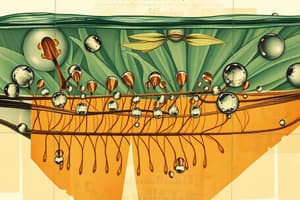Podcast
Questions and Answers
What aspect of botany focuses on the classification and naming of plants?
What aspect of botany focuses on the classification and naming of plants?
- Plant Physiology
- Plant Anatomy
- Plant Morphology (correct)
- Plant Taxonomy
Which group of plants is characterized by the presence of seeds?
Which group of plants is characterized by the presence of seeds?
- Seedless Vascular Plants
- Angiosperms and Gymnosperms (correct)
- Non-Vascular Plants
- Mosses and Liverworts
Which plant structure is primarily responsible for photosynthesis?
Which plant structure is primarily responsible for photosynthesis?
- Flowers
- Roots
- Leaves (correct)
- Stems
What is a major impact of climate change on botany?
What is a major impact of climate change on botany?
Which process involves the transfer of pollen to fertilize flowers?
Which process involves the transfer of pollen to fertilize flowers?
What is studied in plant pathology?
What is studied in plant pathology?
Which statement best describes a key aspect of plant genetics?
Which statement best describes a key aspect of plant genetics?
What role do plants play in ecosystems?
What role do plants play in ecosystems?
Flashcards are hidden until you start studying
Study Notes
Overview of Botany
- Botany is the scientific study of plants, encompassing various aspects of their biology, structure, function, ecology, evolution, and classification.
Key Branches of Botany
- Plant Morphology: Study of the structure and form of plants.
- Plant Anatomy: Examination of plant tissues and cells.
- Plant Physiology: Focus on plant functions, including photosynthesis, respiration, and nutrient uptake.
- Plant Taxonomy: Classification of plants and naming (nomenclature).
- Plant Ecology: Study of the relationship between plants and their environment.
- Plant Genetics: Exploration of heredity and variation in plants.
- Plant Pathology: Investigation of plant diseases and their management.
Major Plant Groups
- Non-Vascular Plants: Includes mosses and liverworts (bryophytes).
- Vascular Plants:
- Seedless Vascular Plants: Ferns and horsetails.
- Seed Plants:
- Gymnosperms: Conifers, cycads.
- Angiosperms: Flowering plants, divided into monocots and dicots.
Plant Anatomy
- Roots: Anchor the plant, absorb water and nutrients.
- Stems: Support the plant, transport nutrients and water.
- Leaves: Main site of photosynthesis; composed of blade, petiole, and veins.
Photosynthesis
- Process by which plants convert light energy into chemical energy.
- Key components:
- Chlorophyll (green pigment).
- Light (sunlight).
- Carbon dioxide (from the air).
- Water (absorbed by roots).
Reproduction in Plants
- Asexual Reproduction: Vegetative propagation (e.g., runners, tubers).
- Sexual Reproduction:
- Involves flowers, pollination, fertilization, and seed formation.
Importance of Botany
- Understanding plant biology aids in agriculture, horticulture, and conservation.
- Plants are essential for ecosystem stability, oxygen production, and as a food source.
- Medicinal plants play a crucial role in healthcare.
Current Issues in Botany
- Impact of climate change on plant distribution and health.
- Biodiversity loss and conservation efforts.
- Invasive species threatening native plant ecosystems.
Botany: The Study of Plants
- Botany is the comprehensive scientific study of plants, covering their biology, structure, function, ecology, evolution, and classification.
Key Branches of Botany
- Plant Morphology: Focuses on the physical structure and form of plants.
- Plant Anatomy: Detailed study of plant tissues and cells at microscopic levels.
- Plant Physiology: Explores plant functions like photosynthesis, respiration, and nutrient absorption.
- Plant Taxonomy: Classifies plants and establishes their scientific names (nomenclature).
- Plant Ecology: Examines the interactions between plants and their environment.
- Plant Genetics: Studies heredity and genetic variation in plants.
- Plant Pathology: Investigates plant diseases and develops management strategies.
Major Plant Groups
- Non-Vascular Plants (Bryophytes): Lack specialized tissues for water transport; examples include mosses and liverworts.
- Vascular Plants: Possess specialized tissues (xylem and phloem) for water and nutrient transport.
- Seedless Vascular Plants: Reproduce via spores; examples include ferns and horsetails.
- Seed Plants: Reproduce using seeds.
- Gymnosperms: Seeds are not enclosed in fruits; examples include conifers and cycads.
- Angiosperms: Flowering plants with seeds enclosed in fruits; further divided into monocots and dicots.
Plant Anatomy: Key Structures
- Roots: Anchor the plant, absorb water and nutrients from the soil.
- Stems: Provide structural support, transport water and nutrients between roots and leaves.
- Leaves: Primary sites of photosynthesis; consist of a blade, petiole (stalk), and veins (vascular tissue).
Photosynthesis: Energy Conversion
- Photosynthesis is the process where plants convert light energy into chemical energy (sugars).
- Requires chlorophyll (green pigment), sunlight, carbon dioxide, and water.
Plant Reproduction
- Asexual Reproduction: Creates genetically identical offspring through vegetative propagation (e.g., runners, tubers).
- Sexual Reproduction: Involves pollination (transfer of pollen), fertilization, and seed formation; commonly occurs in flowers.
Importance of Botany
- Fundamental to agriculture, horticulture, and conservation biology.
- Plants are crucial for ecosystem stability, oxygen production, and are a primary food source.
- Medicinal plants provide numerous healthcare benefits.
Current Issues in Botany
- Climate change significantly impacts plant health and distribution.
- Biodiversity loss necessitates conservation efforts to protect plant species.
- Invasive plant species pose a threat to native ecosystems.
Studying That Suits You
Use AI to generate personalized quizzes and flashcards to suit your learning preferences.




